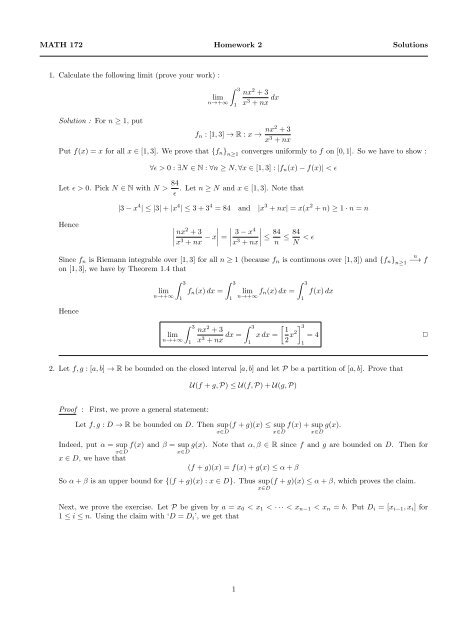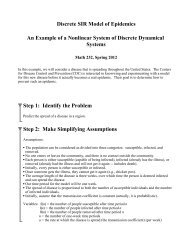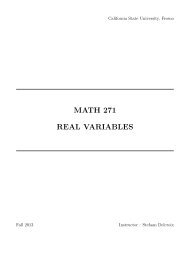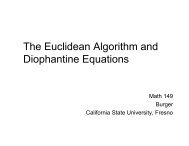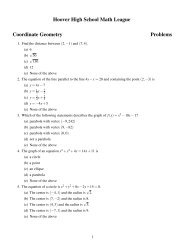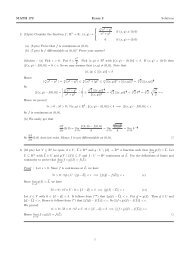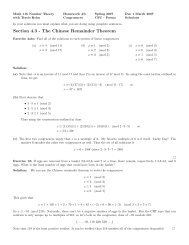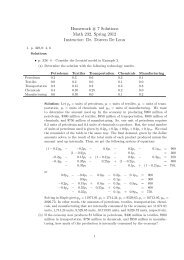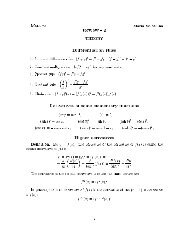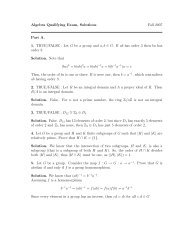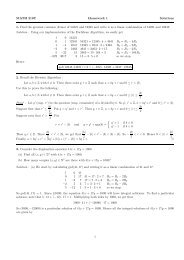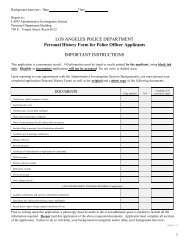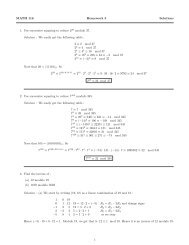MATH 172 Homework 2 Solutions 1. Prove that the following series ...
MATH 172 Homework 2 Solutions 1. Prove that the following series ...
MATH 172 Homework 2 Solutions 1. Prove that the following series ...
Create successful ePaper yourself
Turn your PDF publications into a flip-book with our unique Google optimized e-Paper software.
<strong>MATH</strong> <strong>172</strong> <strong>Homework</strong> 2 <strong>Solutions</strong><br />
<strong>1.</strong> Calculate <strong>the</strong> <strong>following</strong> limit (prove your work) :<br />
Solution : For n ≥ 1, put<br />
∫ 3<br />
nx 2 + 3<br />
lim<br />
n→+∞<br />
1 x 3 + nx dx<br />
f n : [1, 3] → R : x → nx2 + 3<br />
x 3 + nx<br />
Put f(x) = x for all x ∈ [1, 3]. We prove <strong>that</strong> {f n } n≥1<br />
converges uniformly to f on [0, 1]. So we have to show :<br />
∀ɛ > 0 : ∃N ∈ N : ∀n ≥ N, ∀x ∈ [1, 3] : |f n (x) − f(x)| < ɛ<br />
Let ɛ > 0. Pick N ∈ N with N > 84 ɛ<br />
. Let n ≥ N and x ∈ [1, 3]. Note <strong>that</strong><br />
|3 − x 4 | ≤ |3| + |x 4 | ≤ 3 + 3 4 = 84 and |x 3 + nx| = x(x 2 + n) ≥ 1 · n = n<br />
Hence ∣ ∣∣∣ nx 2 + 3<br />
x 3 + nx − x ∣ ∣∣∣<br />
=<br />
3 − x 4<br />
∣x 3 + nx∣ ≤ 84<br />
n ≤ 84<br />
N < ɛ<br />
u<br />
Since f n is Riemann integrable over [1, 3] for all n ≥ 1 (because f n is continuous over [1, 3]) and {f n } n≥1<br />
−→ f<br />
on [1, 3], we have by Theorem <strong>1.</strong>4 <strong>that</strong><br />
Hence<br />
∫ 3<br />
lim<br />
n→+∞<br />
1<br />
f n (x) dx =<br />
∫ 3<br />
1<br />
lim f n(x) dx =<br />
n→+∞<br />
∫ 3<br />
1<br />
f(x) dx<br />
∫ 3<br />
nx 2 ∫<br />
+ 3<br />
3<br />
lim<br />
n→+∞<br />
1 x 3 + nx dx =<br />
1<br />
[ ] 3 1<br />
x dx =<br />
2 x2 = 4 ✷<br />
1<br />
2. Let f, g : [a, b] → R be bounded on <strong>the</strong> closed interval [a, b] and let P be a partition of [a, b]. <strong>Prove</strong> <strong>that</strong><br />
U(f + g, P) ≤ U(f, P) + U(g, P)<br />
Proof :<br />
First, we prove a general statement:<br />
Let f, g : D → R be bounded on D. Then sup<br />
x∈D<br />
(f + g)(x) ≤ sup<br />
x∈D<br />
f(x) + sup g(x).<br />
x∈D<br />
Indeed, put α = sup f(x) and β = sup g(x). Note <strong>that</strong> α, β ∈ R since f and g are bounded on D. Then for<br />
x∈D<br />
x∈D<br />
x ∈ D, we have <strong>that</strong><br />
(f + g)(x) = f(x) + g(x) ≤ α + β<br />
So α + β is an upper bound for {(f + g)(x) : x ∈ D}. Thus sup(f + g)(x) ≤ α + β, which proves <strong>the</strong> claim.<br />
x∈D<br />
Next, we prove <strong>the</strong> exercise. Let P be given by a = x 0 < x 1 < · · · < x n−1 < x n = b. Put D i = [x i−1 , x i ] for<br />
1 ≤ i ≤ n. Using <strong>the</strong> claim with ‘D = D i ’, we get <strong>that</strong><br />
1
U(f + g, P) =<br />
≤<br />
=<br />
n∑<br />
(x i − x i−1 ) sup (f + g)(x)<br />
i=1<br />
x∈D i<br />
n∑<br />
(<br />
)<br />
(x i − x i−1 ) sup f(x) + sup g(x)<br />
i=1<br />
x∈D i x∈D i<br />
n∑<br />
n∑<br />
(x i − x i−1 ) sup f(x) + (x i − x i−1 ) sup g(x)<br />
x∈D i x∈D i<br />
i=1<br />
i=1<br />
= U(f, P) + U(g, P) ✷<br />
3. Let I be an open interval, x 0 ∈ I, and {f n } n≥1 a sequence of functions such <strong>that</strong> f n is differentiable on I for all<br />
n ≥ 1 and <strong>the</strong> sequence {f n (x 0 )} n≥1 converges and <strong>the</strong> sequence {f ′ n} n≥1 converges uniformly on I. <strong>Prove</strong> <strong>that</strong><br />
<strong>the</strong> sequence {f n } n≥1 converges on I to some f such <strong>that</strong> f is differentiable on I and f ′ = lim<br />
n→∞ f ′ n on I.<br />
Proof : Fix x 1 ∈ I. Let J be a bounded open interval such <strong>that</strong> x 0 , x 1 ∈ J ⊆ I. Note <strong>that</strong> f n is differentiable<br />
on J for all n ≥ 1 and <strong>that</strong> <strong>the</strong> sequence {f n} ′ n≥1 converges uniformly on J since J ⊆ I. It follows from Theorem<br />
<strong>1.</strong>5 <strong>that</strong> <strong>the</strong> sequence {f n } n≥1 converges (uniformly) to some function g J (this function seemingly depends on<br />
J) such <strong>that</strong> g J is differentiable on J and g J ′ = lim f n ′ on J.<br />
n→∞<br />
Since this is true for all x 1 ∈ I, it follows <strong>that</strong> <strong>the</strong> sequence {f n (x 1 )} n≥1 converges for every x 1 ∈ I. Hence <strong>the</strong><br />
sequence {f n } n≥1 converges pointwise to some function f on I.<br />
Again fix x 1 ∈ I. Then f = g J on J (from above). So f is differentiable at x 1 and f ′ (x 1 ) = lim f n(x ′ 1 ). Since<br />
n→∞<br />
this is true for all x 1 ∈ I, we get <strong>that</strong> f is differentiable on I and f ′ = lim f n ′ on I.<br />
✷<br />
n→∞<br />
4. Let D ⊆ R and {f n } n≥1 a sequence of functions such <strong>that</strong> f n is uniformly continuous on D for all n ≥ 1 and <strong>the</strong><br />
sequence {f n } n≥1 converges uniformly on D (to some function f). <strong>Prove</strong> <strong>that</strong> f is uniformly continuous on D.<br />
Proof : Let ɛ > 0. Since {f n } n≥1 converges uniformly to f on D, we have :<br />
∃N ∈ N : ∀n ≥ N, ∀t ∈ D : |f n (t) − f(t)| < ɛ 3<br />
(1)<br />
Since f N is uniformly continuous on D, we have<br />
∃δ > 0 : ∀x, y ∈ D : |x − y| < δ ⇒ |f N (x) − f N (y)| < ɛ 3<br />
(2)<br />
Pick x, y ∈ D with |x − y| < δ. From (1) and (2), it follows <strong>that</strong><br />
|f(x) − f(y)| ≤ |f(x) − f N (x)| + |f N (x) − f N (y)| + |f N (y) − f(y)| < ɛ 3 + ɛ 3 + ɛ 3 = ɛ<br />
Hence f is uniformly continuous.<br />
✷<br />
5. Let b n ∈ [0, 1] and f n : [0, 1] → R be integrable over [0, 1] for all n ≥ <strong>1.</strong> Suppose <strong>that</strong> <strong>the</strong> sequence {f n } n≥1<br />
converges<br />
{<br />
uniformly to some function f on [0, 1] and <strong>that</strong> <strong>the</strong> sequence {b n } n≥1 converges to <strong>1.</strong> <strong>Prove</strong> <strong>that</strong> <strong>the</strong><br />
∫ }<br />
bn<br />
sequence f n (x) dx converges to<br />
∫ 1<br />
0<br />
0<br />
n≥1<br />
f(x) dx.<br />
Proof :<br />
Note <strong>that</strong> f is integrable over [0, 1] and <strong>that</strong><br />
∫ 1<br />
0<br />
f(x) dx = lim<br />
n→∞<br />
∫ 1<br />
0<br />
f n (x) dx by Theorem <strong>1.</strong>4.<br />
2
Since 0 ≤ b n ≤ 1, we have <strong>that</strong><br />
∫ bn<br />
∫ 1<br />
∫ 1<br />
f n (x) dx = f n (x) dx − f n (x) dx for all n ≥ 1<br />
0<br />
0<br />
b n<br />
{∫ 1<br />
}<br />
Hence it suffices to prove <strong>that</strong> <strong>the</strong> sequence f n (x) dx converges to 0.<br />
b n<br />
Since f n is bounded on [0, 1] for all n ≥ 1 (f n is integrable) and <strong>the</strong> sequence {f n } n≥1 converges uniformly on<br />
[0, 1], it follows from HW 1 #3 <strong>that</strong> <strong>the</strong> sequence {f n } n≥1 is uniformly bounded on [0, 1]:<br />
<strong>the</strong>re exists some constant M > 0 such <strong>that</strong> |f n (x)| ≤ M for all n ≥ 1 and all x ∈ [0, 1]<br />
n≥1<br />
Let ɛ > 0. Since <strong>the</strong> sequence {b n } n≥1 converges to 1, we have:<br />
∃N ∈ N : ∀n ≥ N : |b n − 1| < ɛ M<br />
Let n ≥ N. Since |b n − 1| = 1 − b n , we get<br />
∫ 1<br />
∫ 1<br />
∣ f n (x) dx − 0<br />
∣ ≤ |f n (x)| dx ≤<br />
b n b n<br />
∫ 1<br />
b n<br />
M dx = (1 − b n )M < ɛ M M = ɛ<br />
✷<br />
3


